Extractivism
Dr May Graham, a Queensland Aboriginal Elder and Academic has neatly summarised the essential contrast between the relationist ontology of Australia’s First Nations cultures, which has underpinned the 65,000 + years of their continuous, sustainable and adaptive way of living in Australia, and that of the extractivist ontology that underpins global capitalism in all its many different forms. She suggests that First Nations people always regarded themselves as part of the natural world, governed by the immutable LAW of their creation ancestral beings to Care for Country. Every aspect of their culture—connection to Country, kinship systems, responsibilities of the Elders and related cultural protocols is based on the truth of the multiple levels of interdependence by which life on Earth operates.
This is something that Westernised global economies from the rapacious capitalism of the US to the authoritarian and oligarchic capitalism of Russia and China, have only really begun to fully understand. Despite the insights of the sciences, it has taken global warming and the climate crisis by which the Earth itself is speaking back in droughts, floods, fires, melting tundra and glaciers and rising sea levels, for the extractivist impulse of modernity to slowly begin to face the biological limits to their expansionist dreams. However, as we can see, outer space beckons as the new frontier so powerful is this impulse.
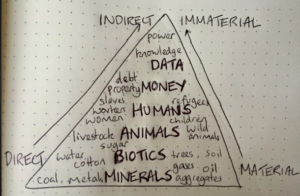 Extractivism draws on a worldview that is focused on how to extract wealth and gain for oneself (family, town, nation state, ethnic group) at the expense of others—the natural environment, animals, birds, oceans and sea creatures, insects—the earth itself through mining its mineral resources, and through science by mapping and using knowledge such as chemistry, biology and physics. In the modern world we have come to accept that extractivism is the basis (something we call productivity) of wellbeing and progress.
Extractivism draws on a worldview that is focused on how to extract wealth and gain for oneself (family, town, nation state, ethnic group) at the expense of others—the natural environment, animals, birds, oceans and sea creatures, insects—the earth itself through mining its mineral resources, and through science by mapping and using knowledge such as chemistry, biology and physics. In the modern world we have come to accept that extractivism is the basis (something we call productivity) of wellbeing and progress.
How to get more with ‘less’—be that with more efficient extractivist technology like factory farming or bio-engineering, or by harnessing the labour of low-wage communities to maximise profit as in the fast fashion industry. It progresses up the ladder from raw minerals to biotics, animals and humans to money (financialisation) to data, the new target of mining all aimed at the manipulation of human behaviour in the name of efficiency and convenience.
The latest manifestation of such extractivism is being played out in the world of digital technologies and platform capitalism—the world of algorithms, social media, search engines and AI.
Genesis and the Other Side of Eden
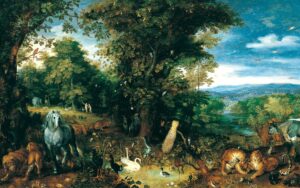
The Garden of Eden
In his book, ‘The Other Side of Eden’ (2001), anthropologist Hugh Brody takes his readers with him into the world of the Inuit, the hunter-gatherers of the Canadian High Arctic of the 1970s, to understand their way of experiencing life and reality. Based on his hunting journeys with the Inuit in a world exposed to the elements, he suggests a marked divide between the worldview of agriculturalists (farmers) and hunter-gatherers. To understand this divide, Brody turns to the story of Genesis and the creation of the world, and man’s exile from Eden.
Brody suggests that Genesis is a prescription of God’s curse on humanity. But, “the curses of Genesis do not stand alone; their cumulative power and meaning are augmented by God’s repeated instruction that human beings must go forth, increase in number, spread out over all parts of the world,, and dominate all other forms of life. . . By the end of the ninth chapter of Genesis, humans are exiles bound to move over the earth, struggling to survive on harsh land, aided by dominance over all other creatures. In their hearts, from first creation, human revel against God’s laws, are ready to kill one another, brother against brother, harbouring evil. . . Their society is one of restlessness, of male supremacy, of a quest for dominance” (p.79).
He concludes that the truth of Genesis lies in the profound and disturbing insight it offers into the heart of the society and economy that comes with and descends from agriculture (p.83). Brody identifies this as the combination of two impulses: a passion to settle, on the one hand—to conquer, hold and tame land through farming; and a preparedness to go out and roam the world—a commitment to maximising profit through expansion rather than to a particular place. He maintains that this leads to a culture/value set whereby love of place is secondary to the importance of prosperity. Given the right price, everything is for sale. The only thing that is sacred, is wealth.
Under extractivism, economic power (the ability to gain/create wealth) is expressed through the ability to control a pool of resources in the interests of the ‘family’—whether that family be an ethnic group, a nation state or a corporation.
Brody traces this imperative of the farmer through to the modern twenty-first executive; their intellectual devices, their categories of thought and their underling interests provide a shared ontology that underpins competing political philosophies, be they liberal democracies, authoritarian dictatorships, or oligarchic cartels.
It is this ontology that the British brought with them to Australia—this preparedness to undertake dangerous sea journeys to an unknown and distant land, to endure the hardships of survival in the establishment of penal settlements characterised by violence and unrest, to forcibly take the land from its original inhabitants for themselves in the name of a ‘civilising’ intent of making better and more productive use of that land, and to then bend that land to their will through the increasingly intrusive power of science and technology.
Extensive land clearing, mono-cultivation of cash crops, the pasturing of hoofed animals on fragile semi-arid landscapes, chemicals to force productivity from the soils (in the same way modern egg production forces chickens into constant egg production), to kill weeds and pests that threatened crop productivity, to use bores to extract water from underground aquifers, to dam rivers, to capture water for irrigation and starve the flood plains, and through logical extension to the factory farming of animals in small enclosures as mere carcasses on which to grow meat for human consumption; to the large factory fishing vessels that denude the oceans or the factory farming of fish such as salmon that pollute waterways.
Clash of World Views (Ontologies)
Brody maintains, however, that contrary to the claims of Religions of the Book (Judaism, Christianity and Islam), Genesis is not the universal creation story of man, in which the Word, text, is the basis of civilisation, and in which aggressive, restless expansionism is legitimised. There is another story, the one we find encoded in the cultures of many First Nations people around the world, which have persisted into the 21st century. These include not only the Inuit whom Brody lived with and wrote about, but also the Sami of Scandinavia with their reindeer herds, the Bushman of the Kalahari Desert in Africa, Amazonian Amero-Indians of South America, pockets of tribal people in India and Indonesia, in Melanesia and in Australia, particularly in the northwest and central Australia, and in Cape York and the Torres Strait islands.
The worldview of these predominantly hunter-gatherer cultures has an entirely different ontology. In contrast to extractivism, its relationist ontology values place as a sacred landscape in which humans live in accordance with the ways of that place alongside its animals and other creatures that call that place home.
In the relationist ontology of the world of the hunter gatherer, instead of seeking to remake and reshape their environment, they rely on knowing how to find, use and sustain that which is already there. Thus they escape the curse of Genesis and forever remain living in Eden, with the conviction that exile must be avoided, that the place of their ancestors which they share with all creatures, is sacred.
Australia’s First Nations cultures, which we can now date back more than 65,000 years provide an interesting extension of this relationist ontology to include aspects of farming, as detailed in Bruce Pascoe’s ‘Dark Emu’ (2014). Using the historical records of early British colonialists, he showed that some Aboriginal cultures did include farming, both of grains and tubers, irrigation, and of river fish using types of traps. Pascoe’s work also draws on the work of Bill Gammage’s ‘The Biggest Estate on Earth’ (2011) that documents the way in which Aboriginal people farmed the entire landscape with fire, using highly sophisticated burning techniques, which today refer to as ‘cultural burning’ to ensure the continued fecundity of the grasslands to sustain the kangaroo population, a major source of food.
Many people greeted Pascoe’s book with acclamation, declaring that this proved Aboriginal “societies were not simple hunter-gatherer economies, but sophisticated, with farming and irrigation practices” (Marcia Langton, University of Melbourne), and called for “Australia to embrace the complexity, sophistication and innovative skills of Indigenous people into its concept of itself as a nation” (Michael Davis, University of Sydney). Others however challenged the very idea that hunter-gatherer societies were/are not equally sophisticated, requiring a detailed and intimate knowledge of landscape, ecologies and the seasons, such as is documented in Brody’s book on the Inuit. What is true is that the sort of agriculture and aquaculture practised by Aboriginal societies did not lead to the exile from Eden through population explosion, constant search for new lands to conquer, and a social system based on extractivism that describes so much of the agricultural world, even before the transformative impact of the European industrial revolutions.
Australia’s First Nations cultures, the most enduring societies on Earth, prove that the clash of world views is not simply between farmer/agriculturalist and hunter-gatherer, but between two ontologies, that of an extractivist mindset versus that of a relationist mindset, as played out in governance systems, social values, kinship systems, and uses of knowledge and resulting technologies.
The clash between these two world views can be found at their intersection with the colonising culture that achieved dominance, particularly in the insistence of the latter that people move into fixed settlements so that they might be more easily provided with modern health and education services, and where they are more easily counted and governed, subject to the laws and logic of the colonisers. The results are the same all over the world, whether it be the Sami of Scandinavia, the Inuit of the Arctic, the native Indian tribes of the Americas, or the Aboriginal and Torres Strait Island people of Australia: pervasive psychic trauma and depression, alcoholism and drug dependence, poverty, frustration, despair and simmering anger.
Ghost Work (2019), by Mary L. Gray and Siddharth Suri
May Gray and Siddharth Suri have exposed a the new face of extractivism – how modern corporations create wealth by extracting it from either human labour or the Earth in order to capture the wealth for those in power, in their book, Ghost Work.
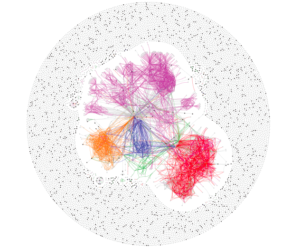 Self-reported locations for participants on MTurk from March 14, 2014, through May 28, 2014. The number of workers reported in each area is proportional to the area of each circle. For example, the circle around Charlotte represents 53 workers, Atlanta represents 158 workers, and New York represents 671 workers. To protect the workers’ privacy we randomly moved the locations they reported by a small amount. Coloration of counties indicates population density. Gregory T. Minton
Self-reported locations for participants on MTurk from March 14, 2014, through May 28, 2014. The number of workers reported in each area is proportional to the area of each circle. For example, the circle around Charlotte represents 53 workers, Atlanta represents 158 workers, and New York represents 671 workers. To protect the workers’ privacy we randomly moved the locations they reported by a small amount. Coloration of counties indicates population density. Gregory T. Minton
Hidden beneath the surface of the web, lost in our wrong-headed debates about AI, a new menace is looming. Anthropologist Mary L. Gray and computer scientist Siddharth Suri team up to unveil how services delivered by companies like Amazon, Google, Microsoft, and Uber can only function smoothly thanks to the judgment and experience of a vast, invisible human labor force. These people doing “ghost work” make the internet seem smart. They perform high-tech piecework: flagging X-rated content, proofreading, designing engine parts, and much more.
Ghost Workers in the US
An estimated 8 percent of Americans have worked at least once in this “ghost economy,” and that number is growing. They usually earn less than legal minimums for traditional work, they have no health benefits, and they can be fired at any time for any reason, or none.
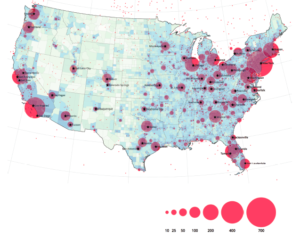 There are no labor laws to govern this kind of work, and these latter-day assembly lines draw in—and all too often overwork and underpay—a surprisingly diverse range of workers: harried young mothers, professionals forced into early retirement, recent grads who can’t get a toehold on the traditional employment ladder, and minorities shut out of the jobs they want. Gray and Suri also show how people doing ghost work, employers, and society at large can ensure that this new kind of work creates opportunity—rather than misery—for those who do it.
There are no labor laws to govern this kind of work, and these latter-day assembly lines draw in—and all too often overwork and underpay—a surprisingly diverse range of workers: harried young mothers, professionals forced into early retirement, recent grads who can’t get a toehold on the traditional employment ladder, and minorities shut out of the jobs they want. Gray and Suri also show how people doing ghost work, employers, and society at large can ensure that this new kind of work creates opportunity—rather than misery—for those who do it.
Self-reported locations for participants on MTurk from March 14, 2014, through May 28, 2014. The number of workers reported in each area is proportional to the area of each circle. For example, the circle around Charlotte represents 53 workers, Atlanta represents 158 workers, and New York represents 671 workers. To protect the workers’ privacy we randomly moved the locations they reported by a small amount. Coloration of counties indicates population density. Gregory T. Minton
Ghost Workers in India
A comparative distribution of ghost AI workers is shown in India, a population with a high proportion of people with IT skills working at programmers, call centre operators, and involved in extensive cyber scamming.
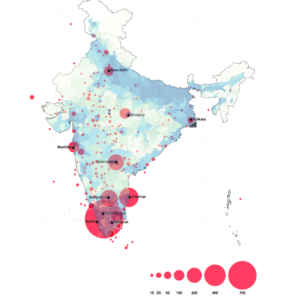
The Human ‘Slaves’ of AI
In her article for ABC Online, technology reporter, Erica Bogle explains how ghost work includes manually tagging photos and video, transcribing audio and categorising text, so when we use a search engine or speak to a voice assistant, the process feels effortless.
This is the “sleight of hand” behind terms like AI or machine learning, according to Sarah Roberts, an assistant professor of information studies at UCLA, who has spent time with workers in the Philippines who do content moderation for companies like Facebook. “Nothing in any of those terms suggest that there are legions of humans that are needed,” she said.
Some of these legions work for Appen, a globally significant and long-term player in the AI Supply Chain. The the Sydney-headquartered company boasts of having 1 million “flexible contributors” in more than 170 countries who do these tasks for clients including Amazon, Google and Boeing.
The ABC spoke with workers who said their pay was around or just above minimum wage in their location.
Appen spokesperson Ms Golden said the company used location-based minimum wage to ensure they were “paying above”.
“I tell my friends and family that while the engineers at Google, Amazon, Apple, etc are like birth parents and private tutors of AI babies, I’m one of the maids sweeping their nursery room and cleaning their clothes,” one worker based in East Asia told the ABC.
“I know that I am a replaceable workforce in this business, but Appen had shown such little respect to its contributors that I was constantly reminded of that fact.”

![Call of the Dakini | A Memoir of a Life Lived [Extract]](https://regenesis.org.au/wp-content/uploads/2023/08/Catalogue-OF-Articles-by-Barbara-Lepani-July-2018-July-2023-.jpg)
Recent Comments